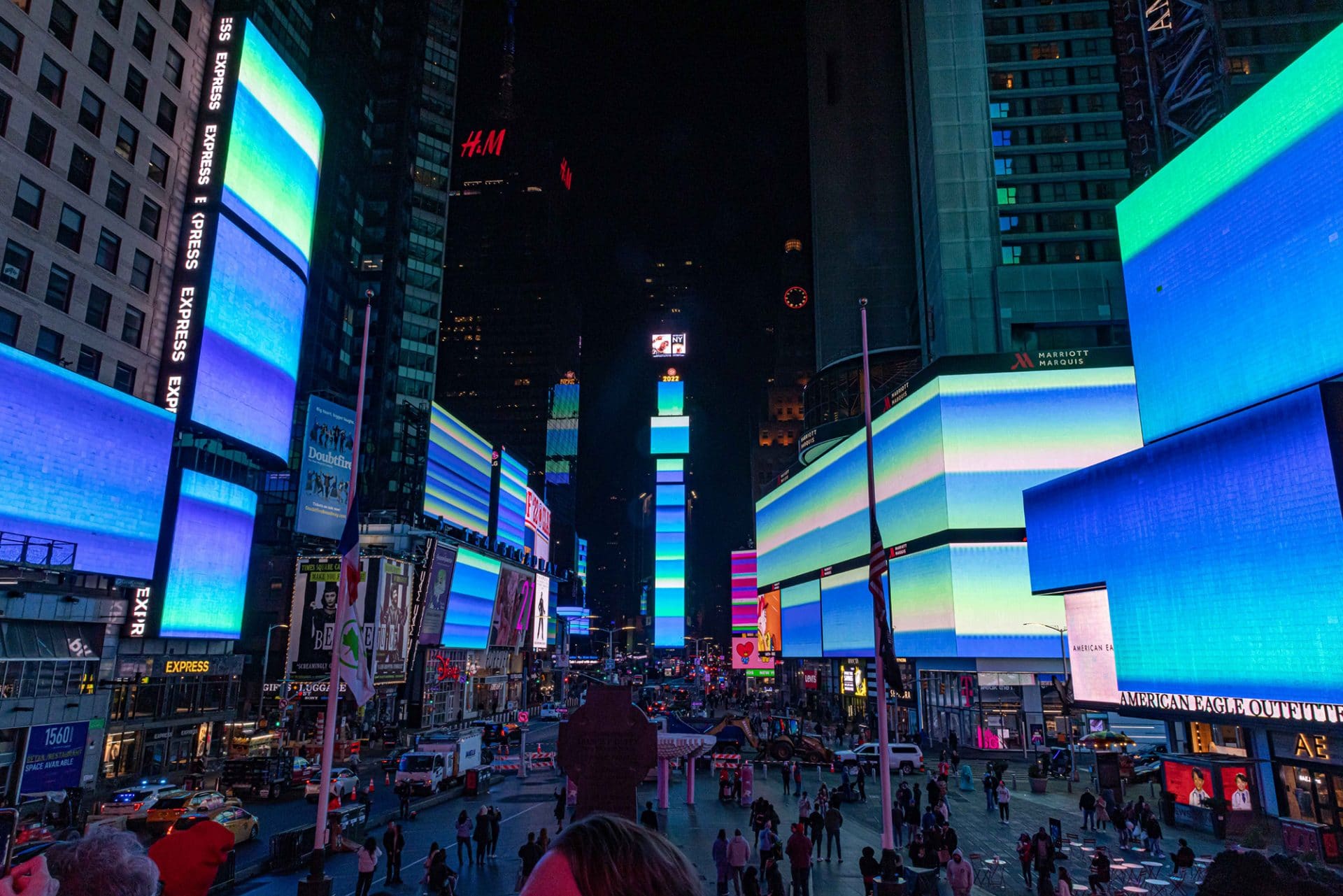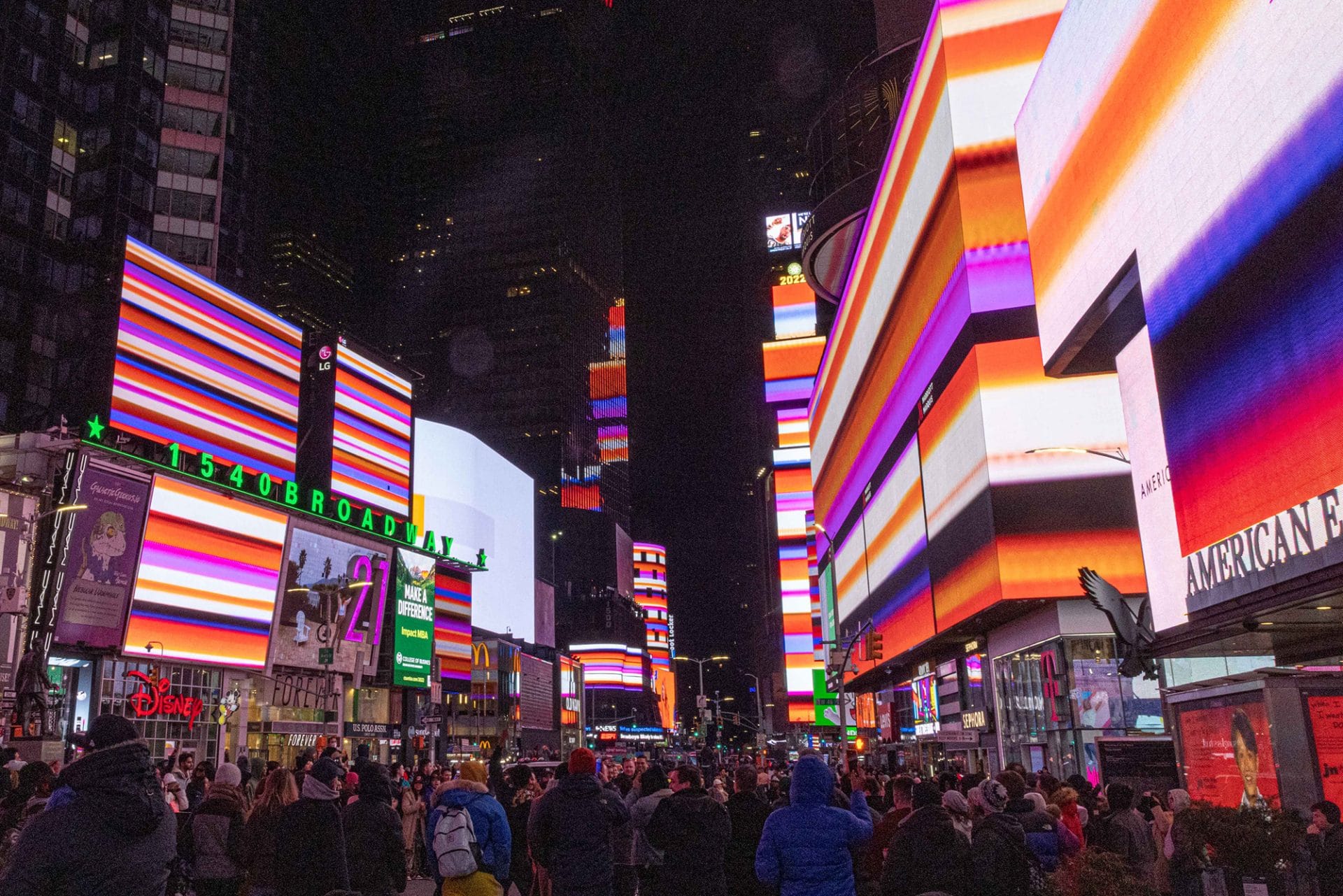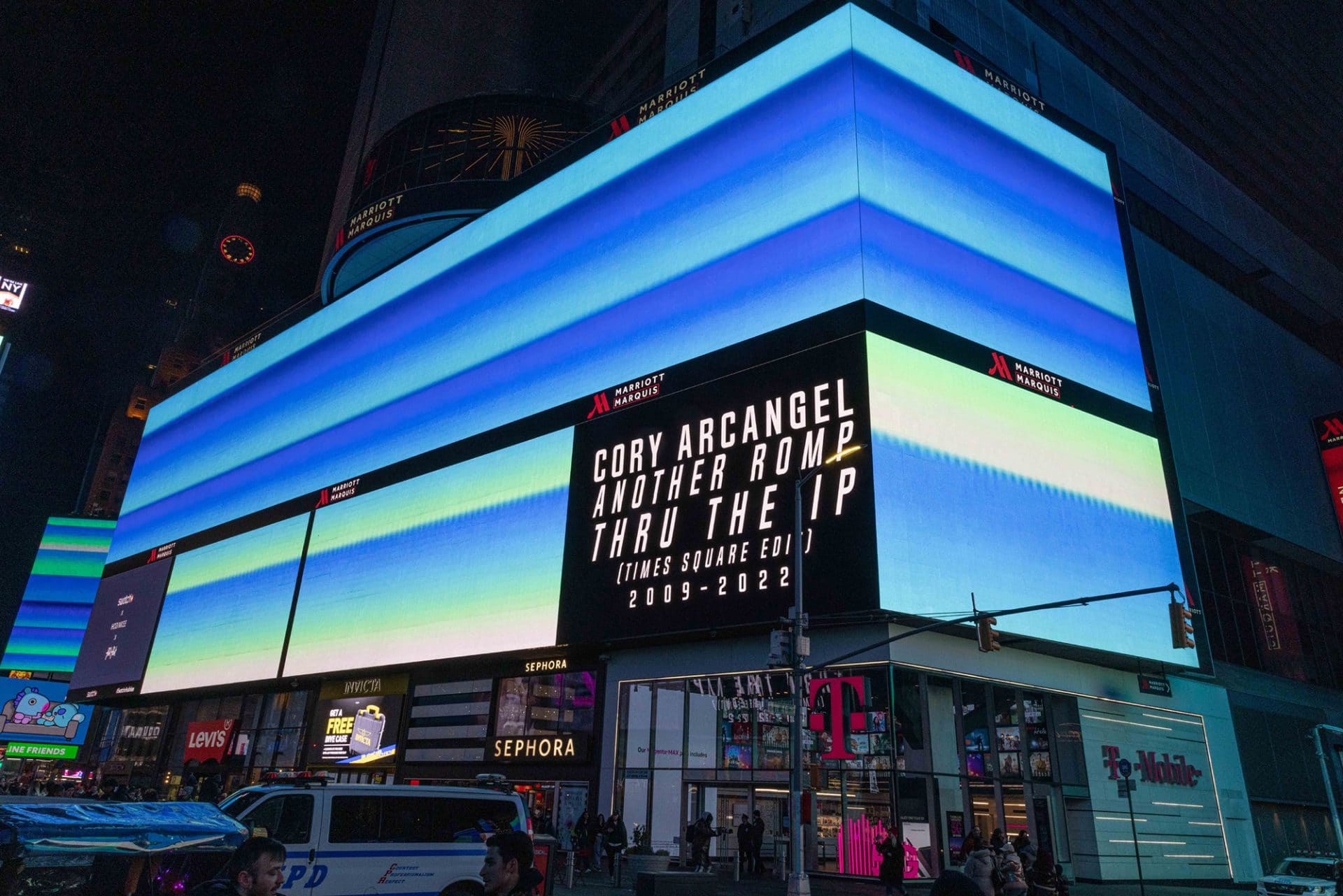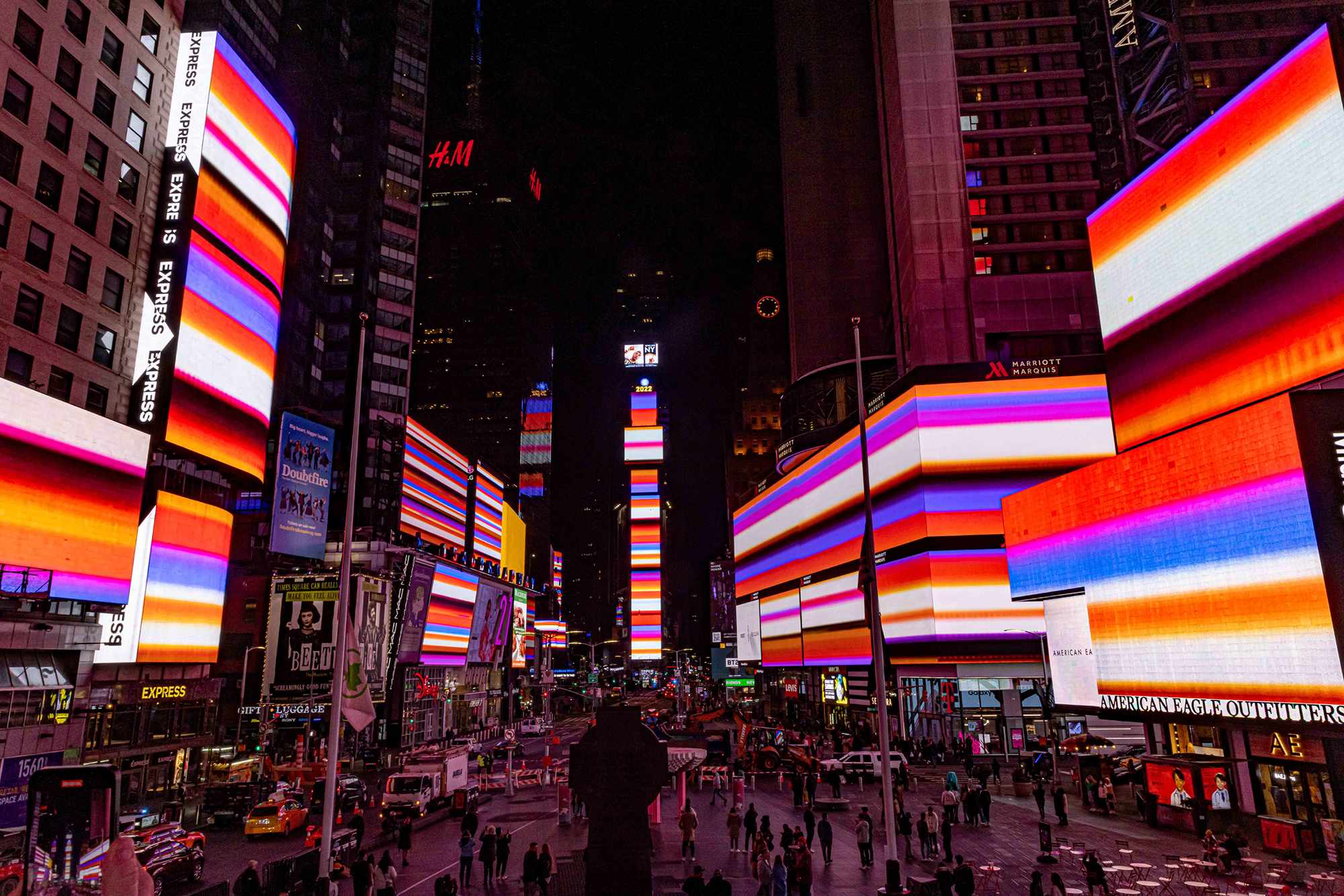Heather Jones: Thanks so much for taking time to speak with me about the Times Square Arts project. However before we jump into that, the last time we at CAS spoke with you about your art and practice was in 2018. It was right before the Arcangel Surfware Flagship store opened in Stavanger. We were sitting in the space, there were paint buckets scattered around… What’s happened since then? Can you give us a brief update?
Cory Arcangel: That feels like 500 lifetimes ago. Let’s see, what have I done since then? I ran the store for 2 years, and officially closed it two or three months before corona. By the time that I finished the store, it had also turned into a kind of off space where I was also doing art shows. I did four shows: Burt Barr, Steina and Woody Vasulka, Oliver Payne and Nick Relph, and Nick DeMarco — three historical shows and one contemporary show which was Nick DeMarco’s. And then I put a nail in it.
HJ: Why did you decide to close it?
CA: When I opened it, I didn’t realize how hard it was to run a store. Of course it was not really a store in the sense that commerce was the aim, but practically it was. Meaning that I sold things, had stock, customers coming in and asking for their size, had accounting to do, and things like that. It was so much work! There were a lot of details that I hadn’t really considered when I decided to open it — like all of them, LØL. And putting on shows is also really hard, as you know.
And then complicating matters, the store also toured! There was so much interest in it, I toured a facsimile version of it to the New York Art Book Fair, New York, Dover Street Market, Los Angeles, and the New Museum, New York. I ended up making a total mirror of the store that could pack down into these little cases that could easily ship to all these places.
After all that, I decided that it was done. Not to say it wasn’t fulfilling. It was. It was easily up there with the best things I had ever done. But I had to start working on my own work again, which was confusing, because the store was my own work!
HJ: Is Arcangel Surfware still an ongoing project?
CA: It’s taking an extended breather.
And then, of course, corona came. I am an artist who does a lot of things online, so all of a sudden I had a lot of opportunities that I wouldn’t have had otherwise. My inbox — and I think a lot of net-artists’ inboxes — really blew up during corona. Because institutions needed content and they were looking for artists who were comfortable with virtual content. So I’ve had a busy couple of years actually.
HJ: How did you handle that sudden influx? Many institutions during that time scrambled to find online content, but didn’t fully understand the online context or have a good frame of reference for what that kind of artwork needs.
CA: Yeah, that’s a really good point. There was a lot of that, but in the end, I had some opportunities come my way that were very clever. Like Screen Slate. Before corona it was a New York City IRL cinema guide, and then they had a bit of fun with it, and migrated online to Stream Slate. We did a live screening of Freshbuzz (www.subway.com), a 2014 film of mine where I just surf dunkindonuts.com. It was cool because at the screening we were on Twitch looking at “me” surfing the internet, so it had all these different layers. I was really glad that came through. Overall, it was cool to have so many opportunities come up, but it required quite a bit of filtering. And I think by the end, most institutions learned a little bit about what it means to put out something online, and what an online space is. It requires a whole different way of thinking.
And then towards the end of corona I had two giant shows. One, Century 21, was at Greene Naftali (and mirrored online via a linktr.ee). That was a show that I worked on for almost all year. And the centerpiece of that show, which was called /roʊˈdeɪoʊ/ Let’s Play: HOLLYWOOD, was a project I had been working on for almost four years. And at the same time, I co-curated with the organist Hampus Lindwall, REMIND ME TOMORROW, a night of new commissions for the pipe organ which took place inside of a cell phone. It’s been really busy couple years!
HJ: So in the midst of all of that activity, how did this Times Square Arts project begin?
CA: They approached one of my galleries, Lisson Gallery, in the fall. They have a long running series called Midnight Moment which is screenings of artworks on the digital boards at Times Square. Over the lifetime of that series, they have convinced 92 companies to give over their screens!
HJ: But just for a few minutes, correct?
CA: Yes, just for three minutes. It’s 11:57 to midnight every night. So they’ve been doing it for a couple years, and every year it grows to be more and more screens. They approached me, and in fact, there was a lot of back and forth. It’s very heavily curated for many different reasons. It’s a nonprofit so it’s not commercially driven. They’re really looking towards poetics. And also, of course, it is Times Square, so it’s one of the most public spaces in the entire world, so that places unique demands on the content. For example, the video couldn’t be too flicker-y because it would be a health hazard, and the video couldn’t be too glitchy because it would read as a public emergency and not an artwork. So there were all these really interesting parameters that were part of the curatorial process. There was a lot of conversation and then eventually we landed on this video that I had in my archive called Another Romp Thru the IP, which I had hoped would be perfect.
HJ: How much experience do you have with this kind of large public artwork?
CA: Very little in the IRL sense. I have a lot of “public artworks,” as net art and internet art is a form of public artwork. So I have a lot of experience with my work floating outside of the art context, but not in this sense where it’s a giant IRL public thing.
HJ: As a whole, your work is grounded in music and in coding, which are very specific languages that most people in the art world don’t speak fluently. That can make it difficult to ask the right questions and write accurately about the work. I know there is a lot behind Another Romp Thru the IP (Times Square edit). I’m going to go out on a limb and ask the very basic question – what is this work? What are we, the viewers, actually looking at?
CA: That’s a great question! We are looking at a three-minute section of moving image material, which was taken from a longer improvisation I did on a Sandin Image Processor analogue video synthesizer.
And to rephrase that in the opposite direction: in 2009 I was standing in front of a Dan Sandin IP, or image processor, a GIANT analogue synthesizer with wires and knobs…
HJ: Like a music synthesizer?
CA: Yes, but it also generates video! There are such things, and this is a very famous one. And I was just playing around on the knobs, and it was outputting to a videotape that I was recording on. It was making these colors, and I was thinking, “well, this looks pretty cool.” And then that was just a tape that I had lying in my archive.
HJ: That wasn’t shown before now?
CA: A different segment of the improvisation was shown in Pro Tools, an exhibition I had at the Whitney Museum in 2011. This videotape was sitting in my archive, and when Times Square Arts approached me with these very specific needs for a work, I went through every video I had ever made, and it was: no, no, no, no, no, no, and then I got to this one and I said, “Huh. Maybe this will work!” I proposed it to them, and they liked it. Then we slowed it down a little bit because there was a part that could have been an epileptic concern. And that slightly slowed down version was then reformatted to fit all the different screens in Times Square. So it was chopped, and little blocks were taken out of it for example. That process was in collaboration with the engineer that Times Square Arts hired that does this every month. And that is what people were seeing in Times Square.
HJ: To be clear, it’s not just the same video multiplied times 92. It is a single video work that has been carved up, so you really have to be in it to see all of it. Is that correct?
CA: It’s actually a little bit of both. Some of the video sections are repeated, but others are not. The screens are so strange! One of the screens is really long and narrow, others are horizontal. The work reads as one video but if you’re looking closely it is actually a couple different parts of one video. That’s also part of why this material worked so well — it’s a video that was able to be pulled apart without losing its structure. And I should note, all this is impossible to test in advance. I was just thinking, “I hope this works!”



HJ: And it did! Are you happy with the way the piece turned out?
CA: Yeah, you know what? It was really, really, really, cool. I flew there and I went with my parents, the Times Square Arts team, and some people from Lisson Gallery and it was a lot cooler than I expected. I got lucky basically. The video has this vertical roll, and a vertical roll on a 10-story billboard looks amazing! It was awesome. The night I was there was really warm so there were a lot of people out and suddenly all of Times Square went completely silent when it was playing. I was like, “Whoa!”
HJ: For people that haven’t been to Times Square, there’s a body-based element of overwhelm when you’re standing there that’s really hard to understand from a video or an image. And then when all of the screens suddenly change and stop playing advertising, you think “Oh no! Times Square is broken!” And then you realize that it isn’t. It’s an artwork.
CA: Yeah! And like I said earlier, it’s really important that the video reads as art really quickly or people will panic.
HJ: Especially given the current state of the world.
CA: Exactly. This video is quite active, so it really got people’s attention quickly.
For me as an artist, the lesson that I learned is that it’s worth it to maintain an archive and be organized. This is a good example of a video waiting for its moment. When you’re an artist who works with digital material, the material itself has no form. So every time you do an exhibition, you get to decide the form. Should it be printed, should it be on a flat screen, a projector, etc…?
The video has this really weird analogue feel which you just wouldn’t get now generating it in some other way. And having it in Times Square with these super bright, super high-resolution screens, and having it be so big and so tall and so wide, it ended up being wild!
HJ: But in this case, you didn’t get to decide the format. The format was prescribed for you. Was that frustrating?
CA: No. When you’re an artist, it’s always more frustrating when people tell you that you can do anything. It’s always better if people tell you what you have to do, or what you can’t do.
In that way, this was a really amazing challenge: there are 92 screens, the thing is going to be chopped up, it’s high-resolution. For me the task was really defined, and it was like the needle in the haystack finding this video. And in the end, to see that it ended up being way better than I thought, I was just so pumped.
HJ: Let’s back up a minute. You mentioned the Dan Sandin image processor with which you made the archived video material. Who is Dan Sandin, and how did you first come across his work?
CA: He’s a well-known artist and technologist. And when I was on a residency at the Institute for Electronic Arts, SOAD, NYSCC at Alfred University in 2009 —they have this video lab with all this old and new stuff — I got to play on a Sandin Image Processor they had. So I just screwed around on that stuff for a couple days and I came away with hours and hours and hours of video footage. It’s a really important part of the story actually.
HJ: Does he know of your work?
CA: Yeah! We emailed a little bit ahead of the opening.
HJ: And he’s positive towards you using and crediting his technology?
CA: Yes. The synthesizer is an open source synthesizer. One of the points of the synthesizer is that it was for other artists to make stuff.
HJ: So it’s a visual instrument.
CA: An instrument! Exactly!
HJ: One thing that I’m personally interested in is being transparent about what it takes to make and present an artwork. Can you describe the process for making Another Romp Thru the IP (Times Square edit)?
CA: Oh yeah. There were several people at Times Square Arts, which is the organization that presented it. And then they had a freelance video engineer who was the expert in these screens and who prepared all 92 videos for all 92 screens. And the cooperation of however many companies run these screens. It’s actually a huge umbrella, a pyramid of people working on this. I mean think of it: to get all the people who have the different companies who run the screens in Time Square to agree to give 3 minutes every night… It’s like Mount Olympus or something. That they have been able to do it – it’s actually shocking!
HJ: It’s almost overwhelming to understand the scope of the creation of this piece. There was Dan Sandin, there was the residency, there’s your archive, there’s your studio, there’s you, obviously, who made the work. Then there’s Times Square Arts and all the people dealing with contracts and organization, and the engineer…
CA: No, you’re right, I didn’t even think about it all the way from the beginning. But that’s what it means to be an artist.
HJ: Is there anything else you’re pushing forward right now? Any upcoming work that you can share publicly?
CA: I’m working on a lot actually!
Two big things are, I’m doing a show at Kunstverein in Hamburg in October. And an upcoming book with Stine Janvin which should be released around the same time if not earlier. If I’m not busy, I’m not happy 😉
Cory Arcangel is a contemporary American multimedia artist. Best known for his post-Internet video art that conflates digital schema and contemporary culture, his work explores nostalgia and the shifting boundaries of online space. It was in 1996, while studying classical guitar at the Oberlin Conservatory of Music, that he first had a high-speed Internet connection – inspiring him to major in music technology and start learning to code. Both music and coding remain his key tools for interrogating the stated purpose of software and gadgets. Outcomes can be surprising, funny and poignant, whether in the final form of installation, video, printed media or music composition, in the gallery or on the world wide web.


